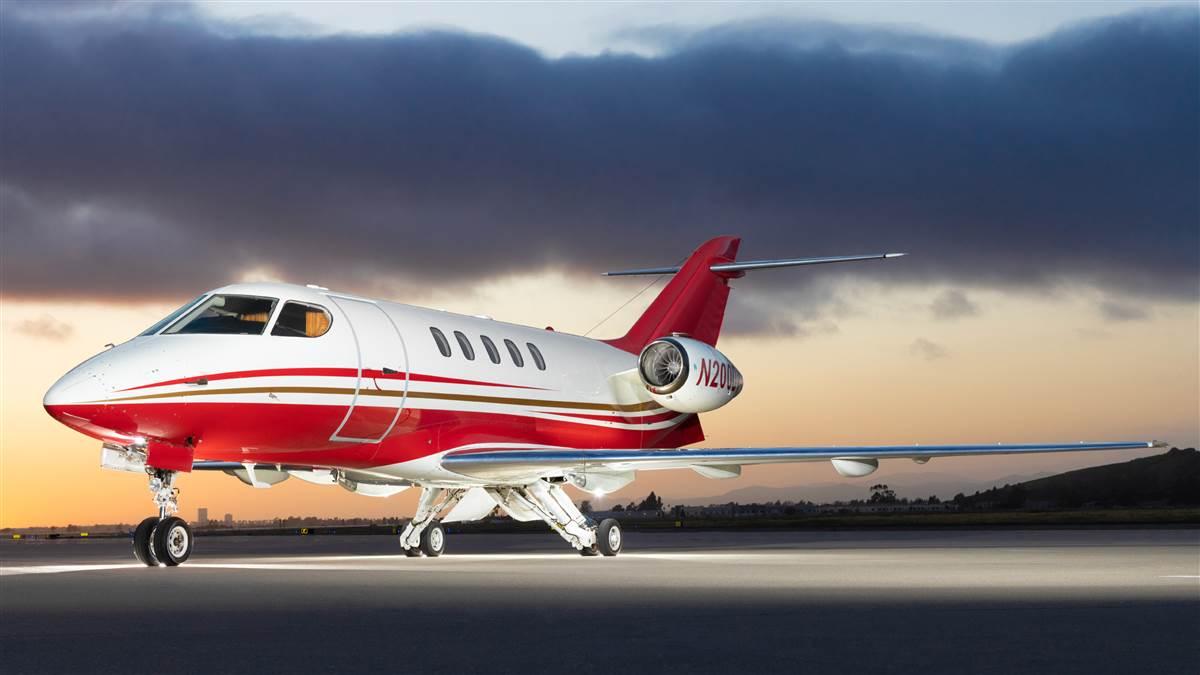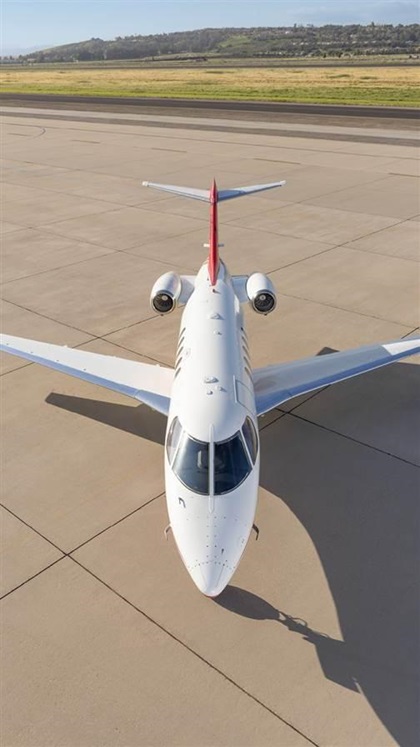Living legend
One man’s pride: The only flying SJ30

For example, there’s Clyde Cessna, Walter Beech, Lloyd Stearman, Harry Hawker (Hawker-Siddeley), Geoffrey de Havilland (the Moth and Otter family, and eventually the Vampire jet), W. T. Piper, and others from the 1920s and 1930s. More recently, we’ve been treated to airplanes offered by Fred Weick (the Ercoupe, Piper Cherokees, and Pawnees), Al Mooney and his eponymous airplane line, Ted Smith (Aerostars, Aero Commanders), Serge Dassault (Falcon jets), Bill Lear and his Learjets, and the Klapmeier brothers (Cirrus).
SyberJet has plans for a new, Honeywell Apex avionics suite to replace its original Honeywell Primus Epic 2.0 package, and said that other retrofits would be forthcoming in upcoming variants called the SJ30i and SJ30x models.To that list, let’s add Ed Swearingen. Although Swearingen began his career as a mechanic working on B–17s, B–24s, and fighters during World War II, he picked up an education in electronics from working in his father’s business. This led to his becoming aviation legend Dee Howard’s first employee in 1947, specializing in installing autopilots. This put him on a path to working with Lear as an assistant director of research and development on Lear’s first design—the LearStar. Then it was back to Dee Howard’s firm in San Antonio, where he worked on the Howard 500, and developed the Howard Super Ventura, a modification of the World War II Lockheed Ventura patrol airplane. Swearingen’s mods boosted the airplane’s cruise speed by 50 mph.
SyberJet SJ30






By 1958 Swearingen had set up his own company, Swearingen Aviation, also based in San Antonio. What followed was design work on Piper’s Twin Comanche, a single-engine prototype of a Comanche with a turboprop engine, then Swearingen’s Excalibur, an upgraded version of the Beech Twin Bonanza. It had new nacelles, landing gear doors, and eight-cylinder Lycoming IO-720 engines that added 60 to 70 mph to the airplane’s maximum cruise speed.
The popular Merlin and Metro series of turboprop twins came next, along with mods to numerous other designs, among them the Lockheed JetStar. Merlins gave Beech’s King Airs competition, and the 19-seat Metros were among the best-selling pioneers in the short-haul airline segment. But an economic turndown forced Swearingen to sell the company to Fairchild Industries in 1971. Still, in recognition of his accomplishments Swearingen was awarded the National Business Aviation Association’s highest honor in 1974, the NBAA Meritorious Service to Aviation Award.
By 1984 Swearingen formed another company and offered up his SX-300 kitplane—a two-seater with a 300-horsepower Lycoming IO-540 engine, a 900-nautical-mile range, and a 240-knot cruise. Brilliant in its conception, the kit proved to be too labor-intensive for the homebuilt market. Plus, it had a 75-knot stall speed and concomitantly high approach speeds. From 1984 to 1989, 80 kits were sold, but supply problems cropped up and only 48 sets of the airplane’s hydraulically actuated landing gear were delivered. In the end, the landing gear supplier Airight Inc. of Wichita acquired the SX-300 tooling and production rights, followed by two Fort Worth owners.
Swearingen’s final design was his SJ30, an elegant six-seat business jet capable of cruising at Mach 0.83 and with a maximum range of 2,200 nm. It had some head-turning features—such as wings with leading edge slats and a 32-degree sweep angle, its swept vertical stabilizer, and landing gear that look for all the world like those of a fighter. The airplane’s tiny main gear assemblies also catch the eye.
There are also some bigger-iron attributes: a whopping 4,800-pound/724-gallon fuel capacity (1,800 pounds in two wing tanks, plus another 3,050 pounds/455 gallons in a fuselage tank); single-point refueling; and optional 10-seat high-density seating. And even though the SJ30 has a maximum takeoff weight of 13,950 pounds, it’s certified for single-pilot operations thanks to its status as an FAR Part 23 airplane in the commuter category.
Alas, the SJ30 met the same fate as Swearingen’s Merlin, Metro, and SX-300. There were numerous setbacks in the early stages of its development, then financial pressures mounted. The first prototype flew in 1996, but the second crashed during a test flight, killing its pilot. Even so, the airplane received its type certificate in 2005, and ground was broken for an SJ30 factory at the Martinsburg, West Virginia, airport. The next year the first SJ30 went to customer Doug Jaffe—a central investor in the company. It’s said that the “SJ” in the type designator stands for “Swearingen-Jaffe,” and the “30” represents Swearingen’s thirtieth design.
The company continued to be plagued with troubled balance sheets, in spite of an order book that neared the 300 mark. First, a joint venture with Taiwan intended as part of an offset for Taiwan’s purchase of F–16 fighters, helped the project. The company name was changed to the Sino-Swearingen Aircraft Corporation. The airplane’s fuselage was stretched, its wingspan lengthened, and it was renamed the SJ30-2. In 2008, the Dubai-based company Emivest became a majority shareholder, and the company name was again changed to the Emivest Aerospace Corporation. But the money ran out and Emivest went bankrupt in 2010.
Today the SJ30 is owned by Metalcraft Technologies of Cedar City, Utah, which supplied the SJ30’s fuselage and sheet metal. Its subsidiary, MSC Aerospace, renamed the airplane the SyberJet, and provides service and maintenance in a site at the airplane’s ancestral home on the San Antonio Airport. SyberJet has plans for a new, Honeywell Apex avionics suite—which MSC calls “SyberVision”—to replace its original Honeywell Primus Epic 2.0 package, and said that other retrofits would be forthcoming in upcoming variants called the SJ30i and SJ30x models. A switch to FADEC-controlled Williams International FJ44-3AP-25 engines is said to be in the works.
For all this, a mere 10 airplanes have been built in the entire SJ30 line. The last one, serial number 10, was delivered to actor Morgan Freeman in 2009 by Emivest. At that time the price tag was $8.3 million. Freeman reportedly sold the airplane back to the company. The rest of the SJ30 fleet has gone to the four winds, with four in the maintenance facility, and one a test article for upgrades.
One SJ30—serial number eight—was built in 2009 and is owned by Brad Howard, a California-based owner of a construction company. He also owns a Twin Commander 690B twin turboprop but began looking around in the late 1990s for a light jet. Deals for an Eclipse and a Safire Jet fell through, so he bought his SJ30 from SyberJet in 2021. It had 1,350 hours on it and had been bought back from a Las Vegas company. Since then he has put around 120 hours on it, including a 52-day trip around Africa.
“It’s everything it should be,” Howard said. “It’s very maneuverable, it’s fast, and it has long legs.” He’s especially taken with the pressurization system. “It’ll hold sea level cabin pressure all the way to 41,000 feet—you can’t find that anywhere. Even up at 47,000 feet the cabin is only at 800 feet. The cabin’s so tight that your ears don’t pop. After all, the fuselage is an inch thick,” he said. “It’s a 12-[pounds per square inch differential] cabin, but I heard that Swearingen did tests that brought the pressure up to 21 psid, and nothing happened.”
Thinking of those small tires and wheels, I asked him if it was difficult to land. “No, not at all,” he said. “I think if you made a bad landing, you wouldn’t even know it.”
Personally, I think the tight geometry and look of the main landing gear resemble that of an F–104 Starfighter, but Howard compares them to those of a Hawker jet. “You do have to keep the tire pressure at 165 psi—plus or minus two psi. That’s why I carry a bottle of nitrogen with me. Bad things can happen to the wheels if you let the tire pressure get too low.” Howard recalled a story about someone who landed an SJ30 with “way low” tire pressure. “The tires went flat, and the plane rolled on its wheels, damaging them beyond repair.”
Howard’s SJ30 was scheduled to go in for maintenance when we talked. He’s hoping to have the original Primus avionics replaced with Honeywell’s Apex suite, which he said was part of the deal when he bought it. A 15-year life-limit on the landing gear’s emergency extension blow-down bottle means the bottle has to be swapped out for a new one, and its location moved from the nosewheel well to a spot inside the cabin to meet a temperature limitation. Work on the speed brake actuators is also on the punch list.
Oh, and his airplane’s Williams FJ44-22A engines are due to be replaced with the -3 model, along with the FADEC system required to control the new engines.
Howard’s airplane is truly unique: Strictly speaking, it’s the only flying SJ30 left (at least at the time this goes to press). It’s an orphan of a classic design with what looks like an uncertain future. There are no SJ30s in Vref or MSC’s website, but SyberJet did take orders for seven more airplanes at the 2019 NBAA convention. Paradoxical but true, Swearingen was an inspired designer, but his conceptions sometimes suffered in their execution. He was wanting—or unlucky—in financial acumen, successor companies faced parts shortages, and upgrades and supplemental type certificates to such a small fleet aren’t worth the effort for most subcontractors to pursue.
On the other hand, there are zero shortfalls when it comes to the SJ30’s performance. It can fly faster, farther, and higher than any other airplane in its weight class, is the best-performing light jet approved for single-pilot operations, holds three Fédération Aéronautique Internationale speed records (one of them from San Antonio to London, England), and to this day still serves as a benchmark that light jet manufacturers use as a measure of their work. And now, in a big way, Brad Howard is the sole custodian of this classic.




